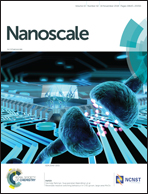Geometric modulation of induced plasmonic circular dichroism in nanoparticle assemblies based on backaction and field enhancement†
Abstract
Chiral cysteine-directed assemblies of Au@Ag core–shell nanocrystals (CSNCs) and Au/Ag nanorods with end-to-end (ETE) and side-by-side (SBS) configurations are fabricated and used to explore the definitive factors affecting the chiral response. The interaction between cysteine and metallic nanoparticles leads to intense and widely tunable plasmonic circular dichroism (PCD) ranging from a near-infrared (NIR) to ultraviolet (UV) regime. More importantly, it was observed that, in Ag nanorod and CSNC samples with varied aspect ratios, the ETE assembled patterns exhibit much larger PCD enhancement than SBS assemblies in an L/D-cysteine solvent environment. Very surprisingly, such a giant PCD response in these assemblies is completely different from that of the Au nanorod assembly case as reported earlier. Experimental and theoretical studies reveal that the interplay between the local field enhancement and backaction, triggered by the geometric configuration differentia of covered achiral CTAB molecules on Ag and Au surfaces, plays a crucial role in chiral response variances and leads to geometry-dependent optical activities. This work not only sheds light on understanding the relationship between the configuration of plasmonic nanostructure assemblies and geometry-manipulated circular dichroism, but also paves the way for predictive design of plasmonic biosensors or other nanodevices with controllable optical activities from the UV to the NIR light range.



 Please wait while we load your content...
Please wait while we load your content...